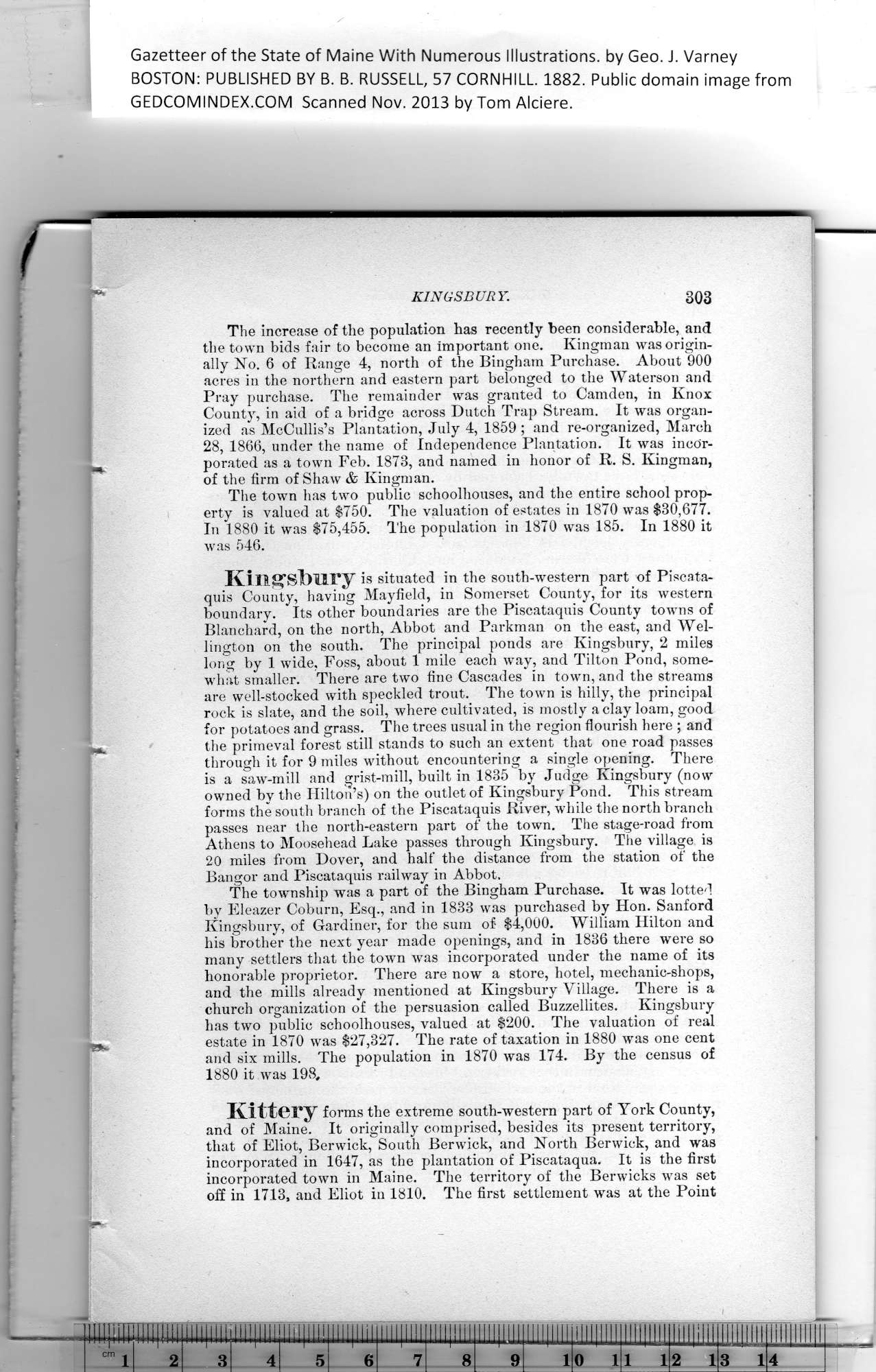|
Gazetteer of the State of Maine With Numerous Illustrations, by Geo. J. Varney
BOSTON: PUBLISHED BY B. B. RUSSELL, 57 CORNHILL. 1882. Public domain image from
KINGSBURY. 303
The increase of the population has recently been considerable, and
the town bids fair to become an important one. Kingman was origin-
ally No. 6 of Range 4, north of the Bingham Purchase. About 900
acres in the northern and eastern part belonged to the Waterson and
Pray purchase. The remainder was granted to Camden, in Knox
County, in aid of a bridge across Dutch Trap Stream. It was organ-
ized as McCullis’s Plantation, July 4, 1859; and re-organized, March
28, 1866, under the name of Independence Plantation. It was incor-
porated as a town Feb. 1873, and named in honor of R. S. Kingman,
of the firm of Shaw & Kingman.
The town has two public schoolhouses, and the entire school prop-
erty is valued at $750. The valuation of estates in 1870 was $30,677.
In 1880 it was $75,455. The population in 1870 was 185. In 1880 it
was 546.
Kingsbury is situated in the south-western part of Piscata-
quis County, having Mayfield, in Somerset County, for its western
boundary. Its other boundaries are the Piscataquis County towns of
Blanchard, on the north, Abbot and Parkman on the east, and Wel-
lington on the south. The principal ponds are Kingsbury, 2 miles
long by 1 wide, Foss, about 1 mile each way, and Tilton Pond, some-
what smaller. There are two fine Cascades in town, and the streams
are well-stocked with speckled trout. The town is hilly, the principal
rock is slate, and the soil, where cultivated, is mostly a clay loam, good
for potatoes and grass. The trees usual in the region flourish here ; and
the primeval forest still stands to such an extent that one road passes
through it for 9 miles without encountering a single opening. There
is a saw-mill and grist-mill, built in 1835 by Judge Kingsbury (now
owned by the Hilton’s) on the outlet of Kingsbury Pond. This stream
forms the south branch of the Piscataquis River, while the north branch
passes near the north-eastern part of the town. The stage-road from
Athens to Moosehead Lake passes through Kingsbury. The village is
20 miles from Dover, and half the distance from the station of the
Bangor and Piscataquis railway in Abbot.
The township was a part of the Bingham Purchase. It was lotted
by Eleazer Coburn, Esq., and in 1833 was purchased by Hon. Sanford
Kingsbury, of Gardiner, for the sum of $4,000. William Hilton and
his brother the next year made openings, and in 1836 there were so
many settlers that the town was incorporated under the name of its
honorable proprietor. There are now a store, hotel, mechanic-shops,
and the mills already mentioned at Kingsbury Village. There is a
church organization of the persuasion called Buzzellites. Kingsbury
has two public schoolhouses, valued at $200. The valuation of real
estate in 1870 was $27,327. The rate of taxation in 1880 was one cent
and six mills. The population in 1870 was 174. By the census of
1880 it was 198,
Kittery forms the extreme south-western part of York County,
and of Maine. It originally comprised, besides its present territory,
that of Eliot, Berwick, South Berwick, and North Berwick, and was
incorporated in 1647, as the plantation of Piscataqua. It is the first
incorporated town in Maine. The territory of tbe Berwicks was set
off in 17.13, and Eliot in 1810. The first settlement was at the Point
PREVIOUS PAGE ... NEXT PAGE
This page was written in HTML using a program written in Python 3.2
|
